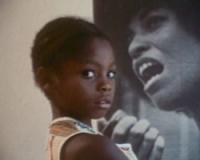In Water Ritual #1: An Urban Rite of Purification (1979), longtime friends Barbara McCullough and Yolanda Vidato collaborate to explore the idea of ritual and its ability to connect two different times and places. The film makes use of materials McCullough and Vidato discovered on-site: a fish head, bits of glass, even a broken Stevie Wonder record. They place these found objects, pieces of a contemporary yet deteriorating urban environment, on the altar with the objects calling back to their cultural past: shells, a symbol of communication with the gods, and cornmeal, a staple food often offered as a sacrifice.
This duality represented in these objects is reflected in Vidato’s character as well—McCullough deliberately presents her as a “third world woman, an island woman, an African woman,” and places her in a burnt-out urban environment behind an abandoned highway. Vidato’s purifying action and McCullough’s documentation of it allow the artists to mix seemingly-disparate spheres of existence: to perform a water ritual in an area ravaged by fire, to engage in the natural world but document it with artificial technology, to live in contemporary Los Angeles but not lose their connection to their African heritage.
For the introduction of Shopping Bag Spirits and Freeway Fetishes: Reflections on Ritual Space (1981), McCullough uses footage from Water Ritual #1 to visually identify the thematic relationship between the films. In this opening sequence, she explains that Water Ritual #1 developed spontaneously as a collaboration between the filmmaker and performer to explore the concept of ritual, and Shopping Bag Spirits extends this project in a more systematic investigation of the ways in which ritual informs art practice for contemporary Black artists working across a broad range of media in Los Angeles.
In their interviews, poets, visual artists, musicians and performance artists both discuss the meaning of ritual in their work and demonstrate their practice on camera. In one such instance, visual artist David Hammons describes his process for improvising compositions with found materials while he creates such a work in an urban lot. As the event unfolds and is captured by the camera, the film becomes both witness to and participant in the process, a dynamic that significantly structures the film. Shopping Bag Spirits is a site for artists to both speak to the meaning of ritual in their work, and a venue for exercising it. Ultimately the meaning of ritual varies across artists, but by asking the question the film is able to capture its scope and complexity in their art practice.
—Bryan Wuest and Karrmen Crey
L.A. in my Mind (2006)

O.Funmilayo Makarah seeks to take her audience beyond the stereotypical images of Black people shown in films and television shows such as "Amos 'n' Andy," Gone with the Wind, and network news programs. Makarah was inspired by a Senegalese filmmaker at a young age to create films that represent Black hope and despair in the face of policies that promote educational, political, social and economic inequities. Later she joined a coterie of documentary filmmakers inspired by Black feminist discourse to document Black women’s lives. Using new and innovative forms such as performance and mixed media, she and other artists show the strengths, limitations and complications that arise when individuals and communities address social and institutional racism. The 1992 Los Angeles Rebellion further inspired Makarah to offer various representations of black communities to stand in contrast with stories ignored and distorted by mass media.
After her period is two weeks late, a young African American woman begins to panic in Zeinabu irene Davis’ Cycles (1989). Accompanied only her own thoughts, she engages in rituals to help pass the time. She attempts to affirm her well being by repeating mantras to herself. Themes of purity, cleanliness and self-reflection are explored as the unnamed woman cleans her home, bathes herself and puts on fresh clothing. Through repetition of thoughts and activities, and accompanied by a beautifully sparse soundtrack, the theme of cycles is brought to the fore. By keeping other cycles in place, perhaps she can forgive herself for the one that seems broken.
Cycles is presented in a beautiful 16mm black and white print.
A Period Piece (1991), the second work in Sunday’s program from director Davis, irreverently documents—in rap form—a feminist response to the endlessly objectionable marketing practices used to sell feminine hygiene products (and also serves as a treasure trove of excellent early ‘90s fashion). Talking back to ads that clearly assume a passive audience, Davis’s short manages to be funny, empowering and subversive at once, which is no small feat for its five-minute running time.
Davis has made three films since Cycles and A Period Piece, including a her first feature, Compensation (1999), which screened at both the Sundance and Toronto International Film Festivals and was nominated for an Independent Spirit Award. Compensation screens at the Billy Wilder Theatre as part of the "L.A. Rebellion" series on December 14th. Davis is currently a Professor of Communication at The University of California, San Diego, where she has been teaching since 2000.
—Dalena Hunter, Jeff McCluskey and Alice Royer






 Mobile Navigation
Mobile Navigation


Comments